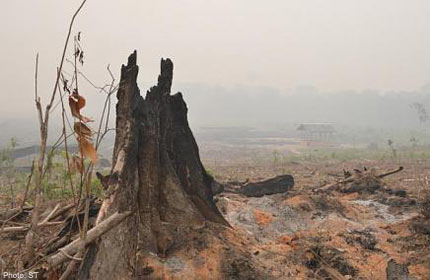
RIAU - Why do people use fire to clear the land when tractors and earth movers can do the job? It is the cheapest way, came the reply from a plantation manager.
"It takes just 10 litres of diesel costing 50,000 rupiah (S$6.40) to flatten 1ha of land," Mr Fadli, who goes by just one name, told The Straits Times.
"In contrast, it would cost more than 15 million rupiah to hire workers and rent excavators to flatten and clear a plot of land that is of the same size," said Mr Fadli, a field manager at a rubber plantation in Pelintung, Riau.
And it would take men and machines one full day to finish the job, he added.
For poor farmers in Indonesia, it is hard economics and not green issues like environment protection that dictates what they do.
This is why they are likely to continue with a practice that has been used for generations, Mr Fadli said. "But we are not like that," he was quick to add.
He insisted his company does not use the slash-and-burn method, but was hard put to explain why there were burnt logs and branches in some parts of the plantation. Also, a worker was using an excavator to flatten land that had obviously been burned.
Mr Fadli declined to reveal the name of the company he works for or the size of the firm.

His boss, who wanted to be known only as Apeng, said it is common for oil palm plantation owners to hire contractors when they want to clear the land.
Some contractors may sub-contract the work. But as sub-contractors are not paid a lot, they tend to choose the cheapest and fastest way to get the job done.
Mr Apeng said the method of clearing the land is often not specified in contracts.
So, when the question of illegal practices arises, the owners are usually absolved of blame. Legally, they have not have broken the law, said Mr Apeng.
On Thursday, The Straits Times team spent 12 hours looking for hot spots and trying to find out the identity of their owners. Many of these plantations are massive, and it takes about two to three hours to get from one to another.
We managed to find three hot spots, but none had signage that would tell us who the owners are.
The firefighters we spoke to also claimed they did not know who owned the land.
Along the way, our team came across many smaller plots of burnt land. At these smaller plantations, we saw that one part of the plantation would be planted with oil palm trees and another part would be burnt. This is what is known as partial burning.
Plantation owners selectively burn parts of their land to clear it for planting new crops.
They would build canals around the plot of land that they intend to burn. After the land is set ablaze, water from the canals is used to put out the fire.
The excavators would then move in to flatten the land and remove burnt tree stumps and branches, leaving no trace of the slash-and-burn method that had been used.
joycel@sph.com.sg
wahyudis@sph.com.sg


